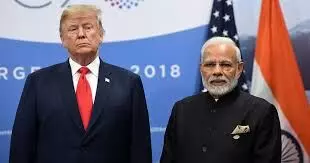India Slams US, EU Over Russian Oil Sanctions: Accuses West of Double Standards in Trade
India slams US and EU for double standards on Russian oil trade, defending its imports while accusing the West of continued business with Moscow.
A student in Mumbai paints an image of former US President Donald Trump and Indian Prime Minister Narendra Modi amid rising trade tensions between India and the West.

India has pushed back strongly against the United States and European Union over mounting trade restrictions and threats related to its continued imports of Russian oil. Accusing the West of hypocrisy, New Delhi said it was being unfairly targeted even as Western nations themselves maintained significant trade relations with Moscow.
In its sharpest rebuke yet, the Indian government called the sanctions and tariffs imposed by the US and EU “unjustified and unreasonable,” suggesting the West is guilty of the very trade practices it now criticizes.
The escalation comes after US President Donald Trump announced plans to raise tariffs on Indian imports beyond the already-imposed 25 percent, citing India’s purchase of Russian crude. The EU, too, recently sanctioned Nayara Energy — a Russian-owned private Indian oil refiner — and banned the import of refined fuels derived from Russian oil.
India Hits Back
Hours after Trump’s latest tariff threat, India’s Ministry of External Affairs issued a strongly-worded statement.
“India will take all necessary measures to safeguard its national interests and economic security,” said MEA spokesperson Randhir Jaiswal. He argued that New Delhi turned to Russian oil only after Western nations diverted their traditional energy supplies from Russia in the wake of the Ukraine conflict.
Jaiswal further accused the West of quietly encouraging India’s Russian oil imports during the early stages of the war. “The United States actively encouraged such imports by India for global energy market stability,” he added.
He pointed out that the EU's 2024 trade with Russia — including record liquefied natural gas (LNG) imports of 16.5 million tonnes — exceeded India’s. Meanwhile, the US continues to import strategic materials like uranium hexafluoride, palladium, fertilizers, and chemicals from Russia.
What’s at Stake?
India’s export-driven economy could take a major hit. The US is India’s largest export market, with Indian goods worth $87 billion shipped to America in 2024. India’s imports from the US stood at $41 billion, resulting in a $46 billion trade surplus favoring India — a gap now threatened by escalating tariffs.
Additionally, EU restrictions on refined oil imports from Russian crude jeopardize India’s thriving petroleum exports to Europe, which grew from $5.9 billion in 2019 to $20.5 billion in 2024.
But experts warn that halting Russian crude imports would cost India billions. After the West sanctioned Russia post-invasion, Moscow began offering discounted oil, making it India’s top energy supplier.
“The West is just shifting goalposts,” said Anil Trigunayat, former Indian diplomat. “India is now holding up the mirror with facts.”
Did the West Approve Indian Oil Imports?
Evidence suggests India’s claims of Western encouragement are accurate. In May 2024, then-US Ambassador to India Eric Garcetti acknowledged India’s role in stabilizing oil prices.
“They fulfilled that [goal],” Garcetti said at a US think tank, confirming India was allowed to buy Russian oil under a price cap policy designed to limit Moscow’s revenues without spiking global oil prices.
Until mid-2025, the EU had not banned refined fuels derived from Russian oil, highlighting the policy shift.
Who Trades More With Russia?
Despite public criticism, Western nations maintain sizable trade ties with Russia.
According to EU data, its total trade with Russia reached €67.5 billion ($77.9 billion) in 2024, while India’s trade with Russia stood at $68.7 billion in FY2024-25. Since the Ukraine war began, EU nations paid $105.6 billion to Russia for gas imports, equating to 75% of Russia’s 2024 military budget.
While Russia’s trade with the EU has declined sharply from pre-war levels, India’s has surged — but experts say that doesn’t justify the double standards.
“They’re still importing from Russia. They’re allowed to do it; we are not. That’s ridiculous,” said Jayati Ghosh, economics professor at the University of Massachusetts Amherst.
Is This a Negotiation Strategy?
Some analysts believe the US pressure campaign is aimed at forcing India into a more favorable trade deal.
Washington and New Delhi have been locked in ongoing trade talks, but disagreements — particularly over agricultural market access — remain unresolved.
“The Trump administration wants India to open its market to US agribusiness — that’s a red line,” said trade economist Biswajit Dhar. “It’s politically and economically unviable for India.”
India’s agriculture sector supports nearly half its population. Experts say any concessions allowing subsidized US agribusiness to flood Indian markets could destabilize millions of small farmers.
Conclusion
India’s blistering response marks a new low in trade relations with the West — particularly as Washington and Brussels try to tighten the economic noose around Russia. But as global geopolitics shift and energy dynamics evolve, New Delhi’s firm stance signals that it won’t be pressured into sacrificing national interests for Western expectations.

